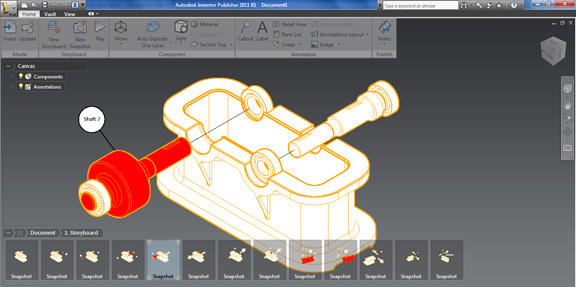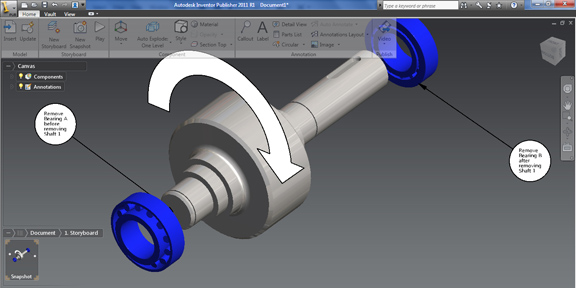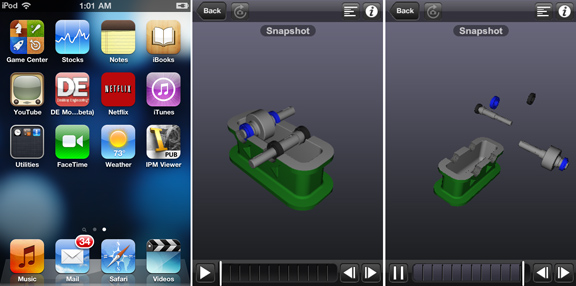Latest News
February 15, 2011



iPhone, iPod Touch, iPad, and Android—to name but a few mobile species now threatening to gnaw away market share once reserved almost exclusively for desktops and laptops. Members of Generation Y—the ones that call Facebook home and would rather text or tweet than pick up the phone—rely on them not just for socialization and distraction but also for learning, training, and problem solving. Assembly required? Need to replace a battery pack? They won’t bother reading a printed manual. Instead, they’ll search through Google for a video clip (and, more often than not, they’ll find it). This explains the latest feature in Autodesk Inventor Publisher 2011—exporting interactive tech documents in a format suitable for mobile devices.
Inventor Publisher is one of the CAD-related professional software packages that someone with limited exposure to CAD can pick up and begin using with almost no training. Most people would probably use it for producing animation sequences and interactive documents, using CAD models already in their possession as starting points. Its close association with Inventor, Autodesk’s primary 3D MCAD package, lets you save a lot of time and effort by using Inventor files in your Inventor Publisher projects. If you need to make a change to the source CAD file, for example, you’ll find that you can simply hit the Update button in Inventor Publisher to bring the new geometry into your document.
Inventor Publisher’s basic features—adding call outs, colors, and arrows—are intuitive and easy to understand. The drag handles it uses to reposition or resize these elements are nearly identical to the method you would use to format 2D images in Microsoft Word, PowerPoint, and Adobe Illustrator, so if you’re marginally familiar with Office products and vector drawing programs, you’d be able to pick up Inventor Publisher in no time. The same may be said of Inventor Publisher’s use of a color wheel to change your parts’ colors.
To create animation sequences, you’ll use snapshots to create interval steps along a time line: for example, remove Bearing A in snapshot one, remove Bearing B in snapshot two, remove Shaft One in snapshot three, and so on. Inventor Publisher 2011 comes with a wide range of preset display styles (a much greater variety than the previous release offers). If you’d like to emphasize a certain part, for instance, you could isolate it and apply a dramatically different style than the rest.
By default, Inventor Publisher exports animations as AVI files. If you don’t pay attention while using the Publish dialog box, you might miss the extra configuration options hidden behind a nondescript button with a series of arrows, right next to OK and Cancel (More or Customize might have been a better label for this button, in my view). With the configuration dialog box open, you can then specify the desired pixel width and height of your video.
To publish to mobile devices, you need a few things. You’ll need a mobile device (obviously), an Autodesk ID (the ID and password you use for Autodesk University or Autodesk Labs should work), and a mobile app called Inventor Publisher Mobile Viewer (free on iTunes app store). When you publish your document, by default it gets uploaded to your private folder on Autodesk’s server.
Another alternative you have is to check the Share option (in the custom configuration dialog box available through Publish). This generates instead a clickable link, emailed to you so you can in turn forward it to your intended recipient. I find this setup a bit daunting, as the link—not a browser-recognized URL but a link recognizable to Inventor Publisher Mobile Viewer app—is not easy to share without a chunk of footnote (otherwise, whoever receives your email would be at a loss as to what to do with it).
A more straightforward approach may be to allow MPEG-4 or QuickTime export, with presets that match typical iPod and iPad aspect ratios. This would make it possible for users to upload the video file to a site, recognizable by any mobile browsers, or forward the file itself to anyone with a mobile device.
If you do choose to publish your tech documents as Inventor Publisher Mobile files, there are some advantages. Unlike an animation file or a video file, you can pause an Inventor Publisher Mobile sequence, rotate it, zoom in, zoom out, and inspect each component from any given angle. Bear in mind, however, that the recipient would need the free viewer installed on his or her device to take advantage of these added functions.
Inventor Publisher 2011 is a professional package with a misleadingly simple interface. The images and documents you can create—Adobe PDF, Microsoft Word, Vector art, and so on—look clean and aesthetically pleasing, without a lot of effort required for formatting and layout. In upcoming releases, I look forward to see more mobile publishing options, along with simpler ways to share the documents.
One open question remains: Currently, imported Inventor assemblies in Inventor Publisher do not exhibit the same constraints and joints you may have specified in Autodesk Inventor. This means you can currently animate imported parts and subassemblies with movements along any axis, even if you may have restricted certain movements in the source file. In a future release of Inventor Publisher, Autodesk may make it possible for you to import Inventor files with original constraints intact, but the company says it needs to figure out the most sensible way to enable this function. What are your thoughts? Is it important to you? Or is it overkill? Please leave your comments here.
For more, watch the video below:
Subscribe to our FREE magazine, FREE email newsletters or both!
Latest News
About the Author
Kenneth Wong is Digital Engineering’s resident blogger and senior editor. Email him at [email protected] or share your thoughts on this article at digitaleng.news/facebook.
Follow DE





